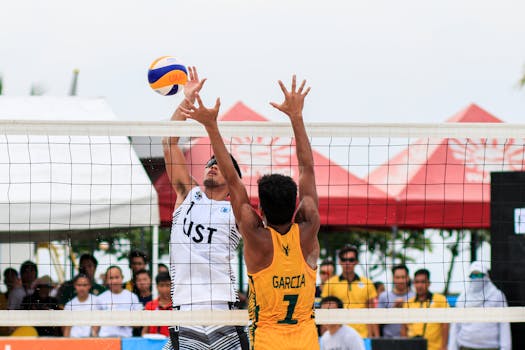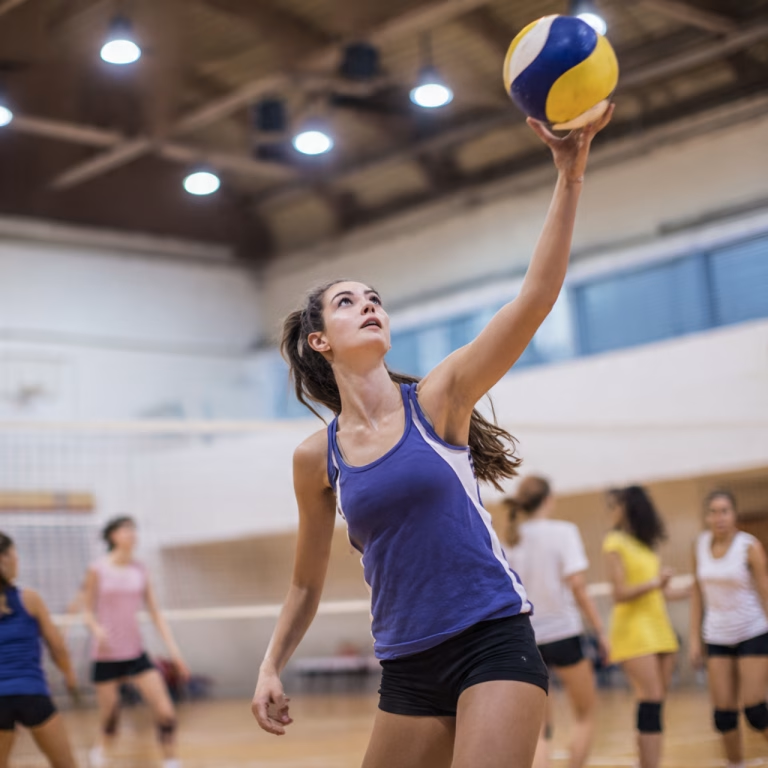One of the most effective defensive techniques in volleyball is the blocking skills, a well-timed and executed maneuver that can turn the tide of a rally. Whether you’re a beginner or a pro, adding these volleyball blocking drills to your training is vital for improving your ability to shut down the opposing team’s offense.
In this comprehensive guide, we’ll look into the world of volleyball blocking drills, exploring various techniques and exercises designed to sharpen your blocking skills. From footwork drills to timing exercises, we’ll cover a wide range of volleyball drills that will help you become a formidable force at the net. So, let’s get started and unlock the secrets to becoming a good defender through blocking skills!
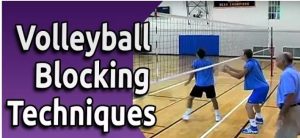
Importance of Blocking in Volleyball
Before we look into the drills, let’s first understand the significance of blocking in volleyball. Blocking is a defensive tactic that involves positioning one or more players at the net to deflect or prevent the opposite team’s attack.
Effective volleyball blocking drills and well-executed blocks can not only stop the opponent’s offensive play but also create scoring opportunities for your team.
Effective blocking requires a combination of physical attributes, such as height, vertical jump, and arm reach, as well as mental skills like anticipation, timing, and court awareness. By mastering the art of blocking, you can disrupt the opponent’s offensive rhythm, demoralize their attackers, and gain a psychological edge over the opposing team.
See Also: 11 Best Volleyball Tactics and strategies to win
Basic volleyball blocking techniques
Before looking into the specific volleyball blocking drills, it’s important to understand the basic blocking techniques. A solid block begins with proper hand positioning, footwork, and timing. When facing a hitter, your hands should be strong, with fingers spread wide to cover as much space as possible over the net.
Footwork is another key aspect. Start in a low, ready stance, then step quickly to align yourself with the hitter. Jump straight up, timing your block to meet the ball as it crosses the net.
For example, if a player is coming in from the outside to spike, you should angle your block to cover the most likely hitting lane. Remember, blocking isn’t just about height—it’s about technique and timing.
Beginner volleyball blocking drills
If you’re new to blocking, start with drills that help you build foundational skills. These volleyball blocking drills will develop your timing, hand placement, and basic footwork.
1. Wall Block Drill
Stand facing a wall and jump repeatedly, simulating a blocking motion. Keep your hands in the blocking position, aiming to touch the same spot on the wall each time. This drill helps beginners get comfortable with the jumping motion and hand placement.
2. Block Footwork Drill
Practice moving along the net by shuffling your feet. Start in your blocking stance, shuffle left or right, and then jump as if you’re blocking an attack. Focus on staying low and moving quickly.
3. One-on-One Blocking Practice
Work with a partner who hits the ball over the net while you block. This drill helps you practice reading the hitter’s approach and reacting quickly.
Intermediate volleyball blocking drills
Once you’ve mastered the basics, you can move on to intermediate volleyball blocking drills that challenge your reaction time and coordination with teammates.
1. Two-Person Block Drill
This drill involves two blockers working together to cover more of the net. Communication is key. One blocker lines up with the hitter, while the other covers the rest of the attack zone. It’s a great way to practice teamwork and coverage.
2. Block and Cover Drill
In this drill, after you block, you immediately cover the ball to help your teammates recover it. The block-and-cover drill helps players transition from defense to offense quickly, enhancing team coordination.
3. Reaction Blocking Drill
This drill tests your ability to react quickly to a fast-paced attack. A coach or another player randomly hits or tips the ball, and you must block it with minimal time to react. The goal is to sharpen your reflexes and anticipate where the ball will go.
Advanced volleyball blocking drills
For more experienced players, advanced volleyball blocking drills focus on perfecting timing, positioning, and adapting to high-speed offenses.
1. Multi-blocker coordination drill
In this drill, multiple blockers work together to cover different hitting angles. This requires excellent communication and coordination between players, as they must decide who will cover which area based on the hitter’s approach.
2. Dynamic Blocking Against Fast Sets
Have a setter deliver quick sets to different hitters, and focus on moving quickly along the net to block each attack. This drill simulates game-like conditions and improves your ability to block in high-pressure situations.
3. Transition from Block to Attack Drill
After blocking the ball, immediately transition into a hitting or passing position. This drill emphasizes the importance of fast transitions and helps develop a complete skill set for front-row players.
Read More:
- Volleyball Bumping Drills for Beginners
- How to Jump Higher in Volleyball
- Volleyball Workouts at Home and the Gym (7-day plan)
Best Volleyball blocking drills
Here are some effective blocking techniques and volleyball blocking drills to incorporate into your training routine:
1. Footwork Drills
Footwork is the foundation of any successful blocking technique. Proper footwork allows you to move quickly and efficiently to the desired position at the net, ensuring you’re in the best position to execute a block. Here are some footwork drills to incorporate into your training routine:
Lateral Shuffle Drill
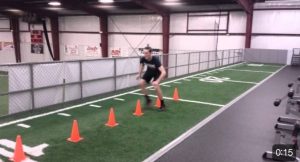
- Set up cones or markers on the court, spaced about 3-4 feet apart.
- Start in a defensive ready position, facing the net.
- Shuffle laterally from one cone to the next, maintaining a low, athletic stance.
- Emphasize quick footwork and proper body positioning.
- Repeat the drill, alternating directions.
Watch it on YouTube.
Crossover Step Drill
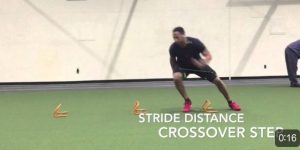
- Set up cones or markers on the court, spaced about 6-8 feet apart.
- Start in a defensive ready position, facing the net.
- Perform a crossover step, leading with your outside foot, to move laterally to the next cone.
- Alternate leading with your left and right foot as you move from cone to cone.
- Maintain a low, athletic stance throughout the drill.
Watch it on YouTube.
2. Timing and Reaction Drills
Timing is everything when it comes to successful blocking. These drills will help you develop the ability to read the opponent’s attack and time your jump and block accordingly.
Coach’s Toss Drill
- Position yourself at the net, facing your coach or a teammate.
- Your coach or teammate will toss a ball over the net, simulating an attack.
- React to the toss by jumping and extending your arms to block the imaginary attack.
- Focus on timing your jump and arm extension to meet the ball at its highest point.
- Repeat the drill, varying the toss locations and speeds.
Blocker’s Vision Drill
- Set up a hitting line on the opposite side of the net.
- Position yourself at the net, facing the hitting line.
- As the hitter approaches, focus on their arm swing and body positioning to anticipate the attack.
- Time your jump and block to meet the ball at its highest point.
- Rotate positions with your teammates to practice blocking from different angles.
3. Blocking Technique Drills
Once you’ve mastered the fundamentals of footwork and timing, it’s time to refine your blocking technique. These drills will help you develop proper hand positioning, arm swing, and body control for effective blocking.
Wall Blocking Drill
- Stand facing a wall, about 2-3 feet away.
- Assume a defensive ready position, with your arms extended in front of you.
- Perform a blocking motion, extending your arms and jumping vertically.
- Focus on keeping your hands together and arms extended at the point of contact.
- Land softly and repeat the drill, emphasizing proper technique.
Partner Blocking Drill
- Pair up with a teammate, one as the blocker and the other as the hitter.
- The hitter will toss the ball over the net, simulating an attack.
- The blocker will react by jumping and extending their arms to block the ball.
- Emphasize proper hand positioning, arm swing, and body control.
- Switch roles and repeat the drill, allowing both partners to practice blocking.
4. Game-Situation Drills
To truly master the art of blocking, it’s essential to practice in game-like situations. These drills will challenge your blocking skills while simulating the intensity and unpredictability of an actual match.
See also:
- Volleyball Hitting Drills – 2024 (New Improved)
- New Improved Volleyball Tryout Drills – 2024
- Grass Volleyball Rules 2024: A Comprehensive Guide for Players
- Middle School Volleyball Rules (2024 Updated)
5. Rotation Blocking Drill
- Set up a full team on each side of the net.
- One team will initiate an offensive play, while the other team focuses on defensive positioning and blocking.
- Rotate positions after each rally, allowing players to practice blocking from different positions on the court.
- Emphasize communication, court awareness, and proper blocking technique.
6. Competitive Blocking Drill
- Divide your team into two groups, with one group on offense and the other on defense.
- The offensive team will attempt to score points by attacking, while the defensive team focuses on blocking and defending.
- Switch roles after a set number of rallies or points.
- Encourage competitive spirit and emphasize the importance of blocking in a game situation.
FAQs
How often should I practice blocking drills?
Incorporating blocking drills into your regular training routine is essential for skill development and maintenance.
Aim to dedicate at least one or two sessions per week specifically to blocking drills, in addition to incorporating blocking elements into your overall volleyball practice.
Is height a significant factor in successful blocking?
While height can be an advantage in blocking, it is not the sole determining factor. Proper technique, timing, and court awareness are equally important. Many successful blockers have overcome height limitations through diligent training and mastery of blocking fundamentals.
How can I improve my vertical jump for better blocking?
Improving your vertical jump can enhance your blocking ability by allowing you to reach higher at the net. Incorporate plyometric exercises, such as box jumps, squat jumps, and depth jumps, into your training routine. Additionally, focus on strength training exercises that target your lower body and core muscles.
How important is communication in blocking?
Communication is crucial in blocking, as it allows you to coordinate your movements and positioning with your teammates. Effective communication can help you anticipate the opponent’s attack and adjust your blocking strategy accordingly. Develop a system of verbal and non-verbal cues with your teammates to facilitate seamless communication on the court.
Final Take (Conclusion)
Volleyball Blocking Drills: Mastering the art of blocking in volleyball is a journey that requires dedication, practice, and a commitment to continuous improvement. By incorporating the drills and techniques outlined in this guide, you’ll be well on your way to becoming a formidable defender at the net.
Remember, blocking is not just a physical skill; it’s a mental game as well. Anticipation, court awareness, and communication with your teammates are essential components of successful blocking. Embrace the challenge, stay focused, and never stop learning and refining your craft.
As you progress through your blocking skills, celebrate your successes, learn from your mistakes, and always strive for excellence. With perseverance and a passion for the game, you’ll elevate your defensive game and become a valuable asset to your team.
The path to becoming a blocking powerhouse starts now!

